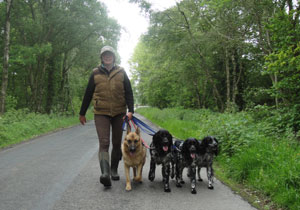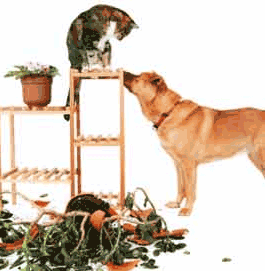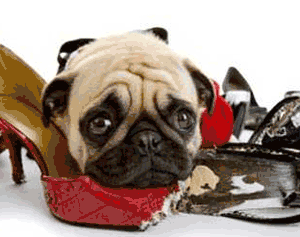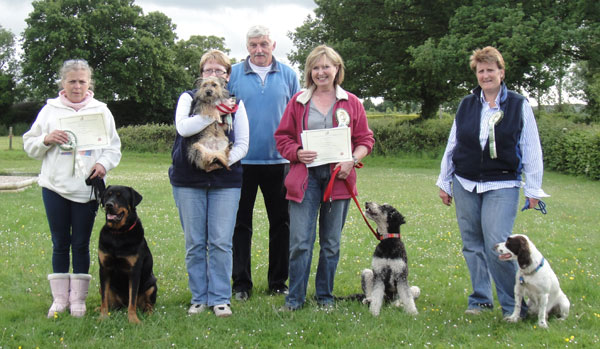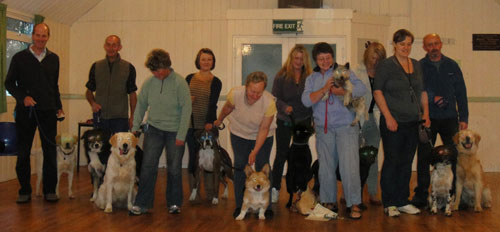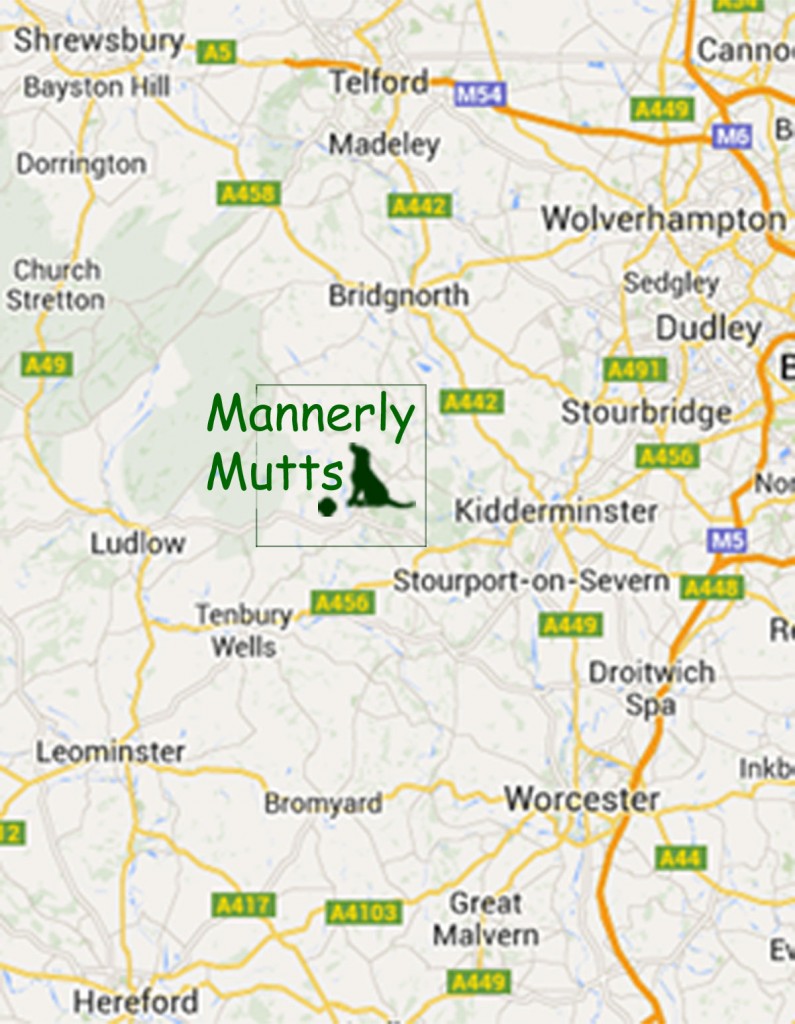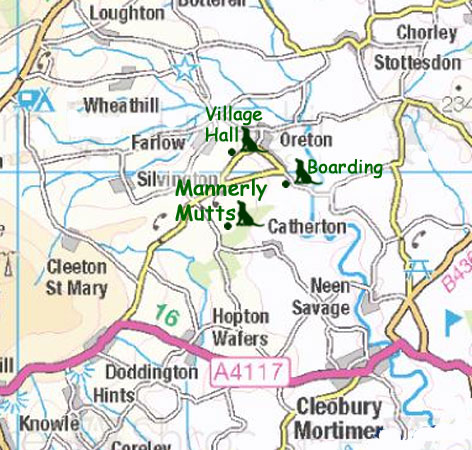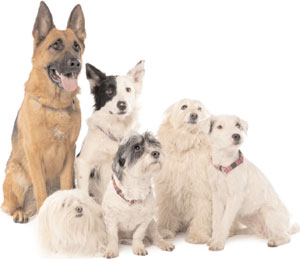
A DOG’S NEEDS
A dog owner must be aware of a dog’s needs and they are:
- Water – A dog needs a constant supply of clean drinking water
- Food – One or two meals a day are suitable for most dogs
- Exercising – All dogs need exercise and where possible they should be taken to places where they can safely run free
- The pack – All dogs need to be able to feel part of the pack
- Leadership – A dog knows there will be leaders within a pack (leaders should not include the dog!)
- Company and affection – Dogs need company and affection without being excessive
RESPONSIBILITIES OF OWNERSHIP
- Register your dog with a veterinary practice and discuss with your veterinary surgeon the necessary vaccinations, frequency of boosters, worming and flea prevention
- Feed the dog regularly a nutritionally balanced diet
- Do not feed the dog from your plate but from the dog’s own bowl
- Dogs like a bed of their own, so provide one
- Rub your hands over the dog’s body to check for burrs, thistles, ticks, or lumps and bumps
- Regularly clean and groom your dog and ensure that no part of the dog’s coat becomes matted
- Bathing is sometimes necessary and should be done in moderation
- Do not allow the dog to be a nuisance to others and ensure control is maintained at all times
- Take great care when entering open spaces where livestock are present and keep your dog on a short lead near all livestock, horses and wild animals
- Always consider the safety of yourself and your dog
- Your dog should not be allowed out on its own
- Do not allow the dog to foul at inappropriate places
- If fouling does occur in a public place always clean up after the dog
- Remember that barking may be a nuisance to others
- Discuss neutering with your veterinary surgeon to avoid unwanted puppies
- Always ensure that your dog is wearing a collar with an identification tag
- Remember that not everyone is a dog lover and they may dislike even a friendly approach from your dog
- Children should be reminded to respect all dogs
- Adults should be mindful that children should never be left alone with a dog
OTHER RESPONSIBILITIES
Socialisation
Dogs should be gradually socialised to other strange dogs, people and children and be familiarised with traffic. Not doing so can cause apprehension. Withdrawing a dog from something that frightens it will only make apprehension worse in the long run. Never make eye contact with an unfamiliar dog. All socialisation should be carried out in a careful manner.
More than one dog
If owning more than one dog, do not initially try to train two or more together. It has to be remembered that, not only will one dog distract the other but when one is admonished, or praised, this will also apply to the other and will be confusing. Always train a dog on a one to one basis with the other out of the way. When both are well behaved individually they can be handled together.
Dogs off lead
No matter how well trained or under control a dog might be, it should never be walked off lead in environmentally unsuitable areas or those that do not permit dogs to be off lead.
Equipment
A dog’s lead should be totally secure and attention should always be paid to worn stitching or a clip that may not be reliable. There are many different types of collar available and handlers should ensure that the one they choose to use is in good condition and will not break under strain. Also it should always be adjusted so that, in the event of panic, it would be impossible for the dog to get free.
Babies, children and dogs
When the family has a baby it is natural that much attention will be given to the new arrival. It is therefore important that the dog does not become jealous. Owners should try to ensure that the dog continues to receive the same love and affection.
CHILDREN
Children are usually less predictable than adults and they should be warned:
- Never to make sudden movements close to a dog.
- Never to scream or suddenly yell close to a dog.
- Never to lunge at a dog, particularly when it is asleep.
- Never to put their face close to a dog’s face.
- Never to eat food close to a family dog.
- Never to tease or pull a dog’s body or coat.
- Never to ignore a dog’s warning growl.
- Always ask permission before touching a dog they do not know.
Note: Children should be reminded to respect all dogs.
BARKING
Excessive barking at home can be a nuisance, and the way the dog is kept at home may inadvertently encourage the problem.
Territorial reasons
Dogs barking for territorial reasons might do so at the front door or a window where they can see people or dogs approaching. In the garden they may do so at the garden gate or a fence. Excluding them from such areas helps to reduce the habit factor.
Predatory or chase instinct
Allowing a dog to constantly indulge in this habit in the garden will exacerbate this problem.
Reasons of insecurity
Constant company and excessive reassurance and touching given to an insecure dog may cause stress when left without the company of people. The result may be barking, whining or howling.
At night
If it is necessary to vocally command a noisy dog at night, it should be done at a distance. This avoids the dog learning how to call its owner back.
DOGS AND STATIONARY VEHICLES
Ventilation for a dog left in a car
Dogs must always be given ample ventilation when left alone in a vehicle. However, during hot weather even windows left wide open and/or shaded may not give sufficient ventilation. In such conditions dogs should not be left in vehicles.
Approaches to a vehicle from strangers
Most dogs are territorial when in their vehicle and may become aggressive if strangers put part of their body in through a window or door.Therefore this should always be prevented.
VEHICLE TRAVEL
The psychology of vehicle travel:
- Dogs or puppies should gradually be accustomed to vehicle travel by taking the dog out in the vehicle for very short training journeys
- Dogs learn to enjoy vehicle travel if they are often taken by vehicle to a place where they have a pleasurable experience.
- Dogs learn to dislike vehicle travel if they are only taken by vehicle to places where they have an unpleasant experience
- How a dog behaves in a vehicle on the first few journeys will form its habits for the future
When travelling in a vehicle a dog:
- Should not be constantly moving around
- Should not be a distraction to the driver
- Should be secure so that, in the event of an accident, injury to canine or human passengers is minimised
HEALTH
Vaccinations
Most veterinary surgeons will administer the first vaccinations at eight/nine weeks.They will advise when the dog can be allowed on the street, parks or mix with other dogs. Discuss with your veterinary surgeon the necessary vaccinations and frequency of boosters.
Fleas
Fleas are usually found around the neck and abdomen of a dog. Owners should regularly look for signs of fleas or their droppings, which appear to be black and no bigger than a grain of sand.There are various products, which will effectively deal with fleas, and veterinary advice should be sought.
WORMING
Roundworms and tapeworms are common in dogs.
Roundworms
There are many kinds of roundworms but Toxocara is the most common.They are a round white worm between three and six inches long. When born nearly all puppies carry Toxocara canis as their mother will have transferred it to them. Badly infected
puppies may pass worms in their faeces or vomit and often appear to be pot bellied.The eggs of Toxocara canis survive for years, therefore great care should be taken in cleaning up after a worm infected puppy or dog.
Tapeworms
Tapeworms are not so common and are less often found in puppies. However, they should also be treated.Tapeworms can be very long but usually small segments, which resemble cucumber pips, may be found in the faeces.
Medication
When worms are evident the dog must quickly be given the right medication.Take veterinary advice about dosing and about preventing infestation in the future, to protect the health of you and your dog, other people, livestock and wildlife.
THE COUNTRY CODE
Chasing
Never allow a dog to chase or worry livestock or wildlife as it raises its predatory instinct and can cause distress, injury and death.
Awareness
Ensure that you know where your dog is and what he is doing at all times. Also be alert to any possible situation where the dog can cause a problem.
Arable land
Provided a dog’s owner keeps it on a lead and on the footpath, dogs are allowed on all public rights of way even if the land either side of the footpath is cultivated.
Gates
Always leave gates as you find them unless instructed otherwise.
Country lanes
These are as dangerous as urban roads and your dog should be on a lead.
Leaving the countryside
Neither you nor your dog should leave anything behind including the dog’s faeces.
MISCELLANEOUS
Dog owners and non-dog owners have the right to live side by side.There are, however laws which must be followed.They are made to safeguard the environment for the benefit of everybody.
Identification
All dogs must normally wear a collar and carry the name and address of the owner when in a public place (including the car).
Fouling
Local authorities have the power to make it an offence if the owner or walker does not clear up dog faeces.This offence is punishable by a fine.
Nuisance and public health
It is an offence for a dog to be kept in such a place or manner as to be prejudicial to public health or a nuisance.
FRIGHTENING, OUT OF CONTROL AND BITING
If a dog is dangerously out of control in a public place, the owner, or the person for the time being in charge of the dog, is guilty of an offence. It is not necessary that the dog injures, merely that there are reasonable grounds for believing that it will injure. Penalties may be as follows:
- An order that the dog is kept under proper control
- A fine
- Destruction of the dog
- A ban on keeping dogs in the future
- Imprisonment
Dangerous dogs
Breeds banned under the Dangerous Dogs Act 1991, including Pit Bull types, are illegal to own unless you have previously been taken to court and proved the dog is not dangerous.The dog is then placed on a list of exempted dogs. Once on this list, it is required that the dog is muzzled in public, registered with the police and neutered.
In the country
If a dog worries livestock on any agricultural ground, the owner, or the person in charge of the dog, is guilty of an offence.
Even letting your dog walk off a lead in the same field as livestock may be considered ‘worrying’. A farmer may legally shoot a dog they consider to be ‘worrying’ their livestock. Note: There are conditions attached to the exercise of this right by any person.
Stray dogs
Every local authority appoints an officer responsible for the seizure of stray dogs. Where the officer has reason to reason to believe that any dog found in a public place is a stray dog, he can seize and detain it. While the dog is detained it must be properly fed and maintained. If the owner is known they must be notified. Any dog not claimed within seven days of the seizure (or the owners notification of the seizure) may be sold or destroyed.
Local dog control measures
In England and Wales, local authorities are empowered to make local rules known as Dog Control Orders to replace old local by certain areas when directed to do so by an authorised officer. The orders can also give authority to ban dogs altogether from certain places, limit the number of dogs that can be walked by one person at any one time, and require you to clean up after your dog. In Scotland it is an offence not to pick up after your dog in a public place.These orders and laws are punishable by fines.
Unnecessary suffering
It is an offence for an owner to cause unnecessary suffering to their dog or cause or permit anyone else todo so. This includes failing to provide food, water and necessary veterinary attention.
Abandoning
Temporary and/or permanent abandonment of a dog that causes suffering is an offence.
Dogs and food outlets
By law, dogs are not allowed into an area of restaurants or shops where food is prepared. Dogs are allowed where food is served at the discretion of the proprietor; there is no law banning dogs from areas where food is served. It is understood that owners will keep their dogs under control, and may be required to leave by management.
Medical Treatment
It can be an offence for someone other than a veterinary surgeon to provide medical treatment to a dog other than emergency first aid.
Dogs knocked down by vehicles
Any motorist that knocks down a dog must report the incident to the police within 24 hours.
Third party claims and insurance
If a dog causes injury or damage to a person or property, the injured party can make a claim against the dog’s owner. Often household contents policies cover third party claims against the dog but it is wise to check.You may wish to consider additional insurance cover for veterinary bills.
THE PSYCHOLOGY OF LEARNING
Learning by habit :
A dog learns by habit, therefore he is likely to repeat an experience that was pleasurable and avoid an experience that was not. Every time he does something the habit becomes more ingrained. Therefore we should encourage and praise the good habits, and discourage the bad habits.
Inconsistency
Inconsistency causes confusion. If a dog learns by habit, our praise or discouragement allied to the dog’s habit must be prompt and consistent to advance the learning process. When play and learning are linked the result is a happy dog.
Analysing problems
When there is a problem with your dog’s training do not immediately work at the symptom. Instead try to think like a dog to find the cause of any problem before attempting to reverse it.
Teaching disobedience
If dogs learn by habit then it is easy to teach disobedience.To continually repeat commands that a dog disobeys is therefore to teach disobedience to that command.
Natural learning
When a dog performs naturally an act which is desirable to us, i.e. sitting when we stop walking, if we consistently add the appropriate command to the dogs natural action, the dog will learn to obey the command as a matter of course.
 Let us suppose you are considering purchasing a puppy. The first steps are so important, ask yourself and do please be honest would the pup choose you as its owner! I have experienced lots of families new to dog ownership and and here are a few considerations to help.
Let us suppose you are considering purchasing a puppy. The first steps are so important, ask yourself and do please be honest would the pup choose you as its owner! I have experienced lots of families new to dog ownership and and here are a few considerations to help.